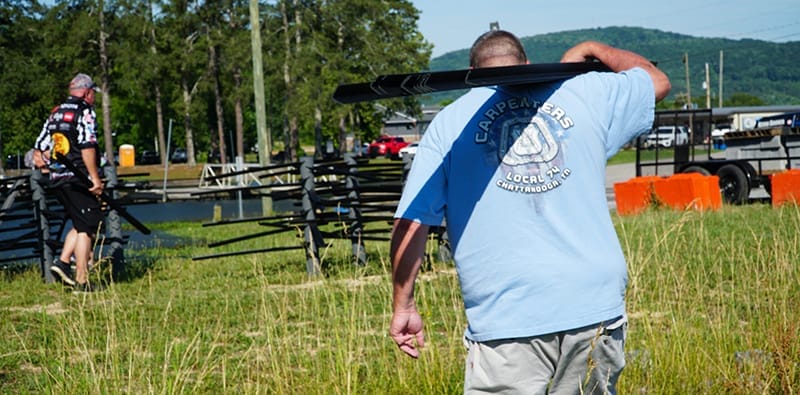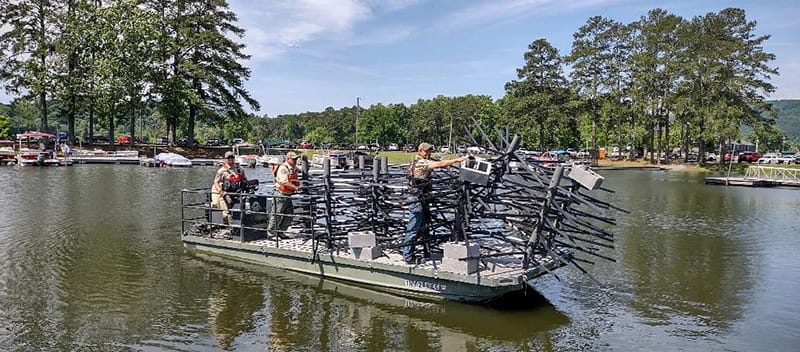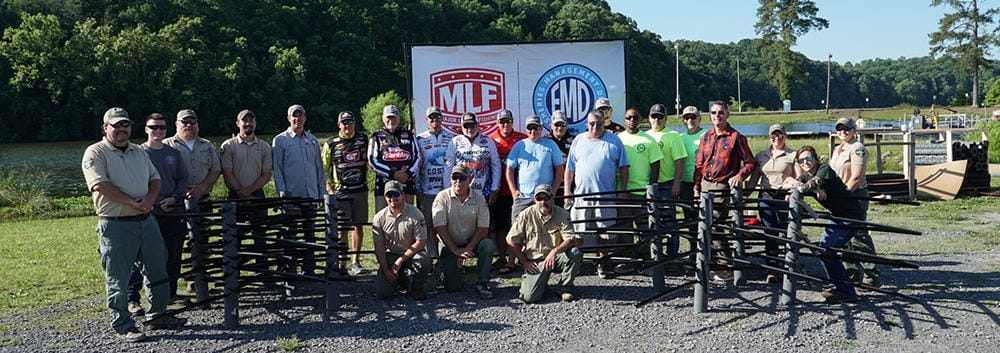Union Members Assemble 36 Fish Habitats for Tennessee’s Chickamauga Lake
Union Sportsmen’s Alliance supports Major League Fishing’s Fisheries Management Division and TWRA
by Kate Nation
In partnership with Major League Fishing’s Fisheries Management Division (MLF-FMD), the Union Sportsmen’s Alliance (USA) and its union volunteers joined forces on June 4 with the Tennessee Wildlife Resources Agency (TWRA) and a handful of MLF anglers for a fish habitat enhancement project, supported by Berkley Labs, to benefit Tennessee’s Chickamauga Lake.
Union volunteers representing Ironworkers Local 704, Electrical Workers Local 175, and Carpenters Local 74 met up with MLF anglers Casey Ashley, Josh Bertrand, Tommy Biffle, Roy Hawk, Kelly Jordon, and Skeet Reese and MLF-FMD staff at the Dayton Boat Dock on Chickamauga Lake to assemble 36 MossBack Fish Habitat products, which were deployed in six locations within Richland Creek.
“The union volunteers arrived early and got to work right away with very little explanation,” said MLF-FMD biologist Steven Bardin, who previously worked with USA volunteers on fish habitat builds in Oklahoma and Alabama. “They were an excellent addition to the project because skilled labor is always the hardest part to get these projects done efficiently, and your volunteers always provide that.”

USA’s union volunteers helped assemble 36 MossBack fish habitats.
Located between Chattanooga and Dayton, Tennessee, Chickamauga Lake is a 36,200-acre reservoir that stretches from Watts Bar Dam to Chickamauga Dam. In 2018, Bassmaster named Chickamauga Lake the Number 2 Best Lake in the U.S., and the reservoir still holds the state record largemouth bass, which weighed 15.20 pounds, set in 2015.
“A lot of people from across the country come to fish the lake for bass, crappie, and a variety of other popular sport fish,” said Joey Root, TWRA reservoir fisheries manager with the Region 3 Reservoir crew. “It’s nationally recognized, so it’s important for us to keep up with the demands of the anglers and make it a great fishery.”
According to MLF-FMD biologist Steven Bardin, “much of the natural fish habitat once found in many of our reservoirs has been buried by siltation or slowly degraded over time as it decomposes. This habitat loss must be addressed if we plan to continue to support healthy fish populations.”
Richland Creek was selected as the home of the 36 MossBack habitats because it is “super productive for pretty much every sport fish species in the reservoir,” Root said. “Crappie and bass use the creek arm to spawn. It’s also a stocking site for Florida strain largemouth bass, and it’s really good to have that habitat to increase the survival of the stocked fish.”

Thirty-six MossBack artificial structures were installed in Tennessee’s Richland Creek to benefit Chickamauga Lake fisheries.
Bi-annual sampling in Richland Creek for bass and crappie will enable TWRA to monitor the impact of the habitat introduction on fish abundance.
TWRA Region 3 manages nine reservoirs. “It takes a lot of work and hundreds of structures to even make a dent in a fishery, so having all those hands on deck is a huge help, and it’s really cool to have the volunteers there to see what’s involved in fisheries management,” Root said. “This is a great partnership, and I look forward working together in the future.”
“Many building trades members in our area recreate on Chickamauga Lake because it’s so close,” said Sean Paul Kimball, Ironworkers Local 704 business manager/financial secretary-treasurer. “Projects like this one enable them to use their skills to give back to the community where they live, fish, hunt, and play in the outdoors every day.”
“Through our Work Boots on the Ground conservation program, the USA reaches into local communities to create and improve access and opportunities in the outdoors,” said Forrest Parker, USA director of conservation and communications. “Combining the USA’s union volunteers with the resources and influence of Major League Fishing through fish habitat projects in Tennessee, Alabama, Oklahoma, and other states in the future, will propel both of our organization’s efforts to pass on the fishing heritage to a whole new level.”




